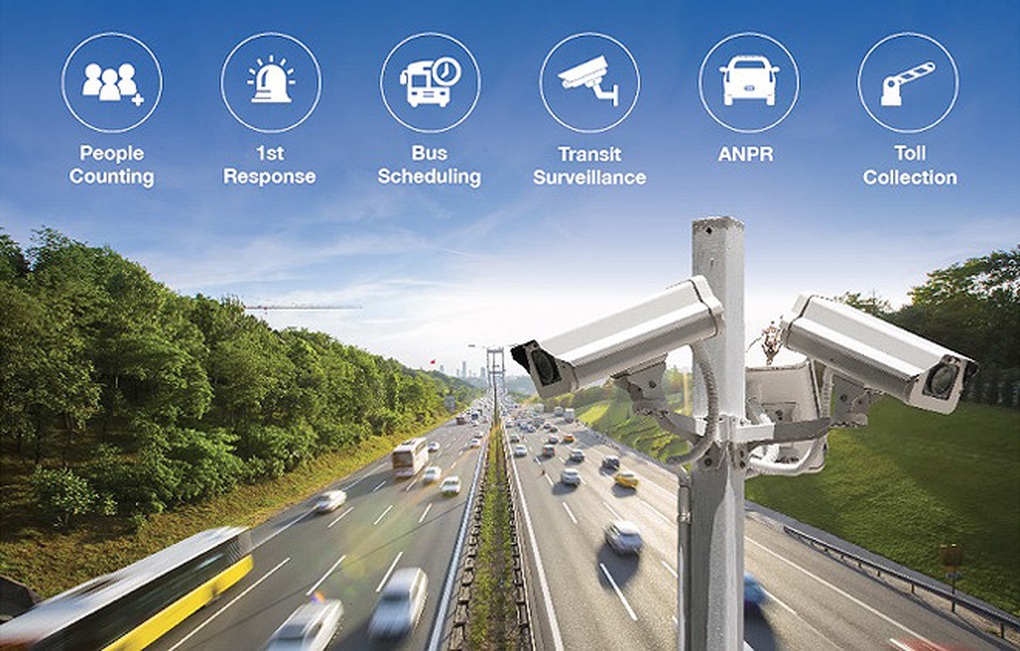
Smart transport systems help reduce congestion and accidents, and improve the efficiency of public transport (Illustration: ST).
Limitations on capital, human resources and system synchronization
As a global trend, smart transportation is being deployed in many countries to solve urban problems such as congestion, accidents, air pollution, low public transport usage rate...
In Vietnam, many large cities have also begun piloting the ITS system.
According to experts from Viettel Solutions, most localities are now fully aware of the importance of ITS in improving management capacity, reducing congestion, ensuring safety and moving towards sustainable urban development.
ITS (Intelligent Transportation Systems) is a collection of solutions and technologies including sensors, cameras, AI, IoT, Big Data, cloud computing... applied in traffic management, operation and monitoring, aiming to: Reduce congestion and accidents; improve the efficiency of public transport; provide real-time information to traffic participants; support management agencies in building smart and sustainable urban areas.
However, when entering practical implementation, many localities still face difficulties due to four major barriers: lack of investment capital, lack of specialized human resources, lack of synchronization of data and fragmented systems due to using solutions from many different suppliers.
"Among them, the investment capital problem is still the biggest challenge," said an expert with experience in successfully deploying more than 20 ITS systems domestically and abroad such as Dubai, Peru, and Kuwait from Viettel Solutions.
Especially in provinces and cities with limited resources, local budgets are not enough to cover the initial investment costs for digital infrastructure, equipment, control centers, as well as maintaining the operation of a complex and highly technical ITS system.
Along with that, human resources are also a significant barrier. The lack of expertise in technology, communications, data analysis and smart system operations makes it difficult for many localities to maintain ITS effectiveness.
In reality, most local traffic or information technology staff have not received specialized training to meet the requirements of operating modern systems.
In addition, the lack of synchronization and the risk of system fragmentation further aggravate the problem.
Experts pointed out that some localities have implemented partial testing such as surveillance cameras, traffic lights or violation handling software, but due to using solutions from many different suppliers, the system cannot be integrated, leading to data being scattered and difficult to exploit effectively.
Inter-sectoral data connection and sharing also face obstacles due to the lack of standardization and coordination mechanisms between departments and sectors.
This is the "bottleneck" that makes building an overall operations center difficult.
Policies, standards and initial steps
In 2024, the Ministry of Science and Technology issued the national standard TCVN 13910 (compatible with ISO 14817) consisting of 3 parts: ITS data definition, data concept registration management, and object identifier assignment.
This is the first legal corridor for standardizing and sharing ITS data on a national scale.
The Government also aims to install ITS systems on 100% of expressways by 2025, while establishing smart urban management and operation centers and a non-stop electronic toll collection system (ETC).
On the Hanoi - Hai Phong expressway, a synchronized ITS system has been applied with surveillance cameras, electronic incident warning boards, and non-stop toll collection, becoming a typical example of how ITS can help reduce congestion and improve operational efficiency.
However, according to independent experts, despite clear standards and goals, there is still a large gap in implementation. The application of national standards is not consistent among provinces, the inter-sectoral coordination mechanism is still loose, and especially the agency in charge of managing ITS data at the national and local levels has not been clearly identified.
Key Point: Consistency
According to experts, to solve this problem, it is necessary to develop a suitable investment roadmap, prioritizing the reuse of existing infrastructure such as cameras and traffic light systems to optimize the budget.
At the same time, localities need to reduce their dependence on intermediaries by taking advantage of large-scale digital transmission infrastructure, strong bandwidth, and modern cloud computing platforms. Choosing a provider with strong infrastructure advantages will ensure stable operations and long-term cost savings.
In addition to infrastructure, an experienced technical team plays a key role in training and capacity building for local staff. The application of core technologies such as AI, IoT, and Big Data also allows for the automation of many processes, reducing the burden of human resources in the early stages.

A complete ITS system needs to include many subsystems: intelligent traffic control, traffic simulation, violation handling, public transport management (Illustration: Nexcom).
A key point is synchronization. If the system is not connected or fragmented, efficiency will be limited. Therefore, solutions need to be highly compatible, able to integrate flexibly with legacy systems via data communication standards, and even build custom adapters to unify data.
According to experts, a complete ITS system needs to include many subsystems: intelligent traffic control, traffic simulation, violation handling, public transport management, incident management, route information provision, and parking management.
Subsystems can be deployed individually or synchronously, but must ensure that they do not cause fragmentation.
In particular, the problem of connecting and sharing inter-sectoral data can be solved by an open connection mechanism, allowing the integration of data from departments, agencies, and sectors (transportation, police, urban areas, and residents) to the control center, ensuring that data is shared according to real-time standards.
This is an important foundation for building a safe, efficient and sustainable smart transportation ecosystem.
Source: https://dantri.com.vn/khoa-hoc/rao-can-khien-giao-thong-thong-minh-chua-the-but-toc-20250912125632780.htm





![[Photo] Thac Ba Lake: Towards an international-class tourism, resort and cultural center by 2040](https://vphoto.vietnam.vn/thumb/1200x675/vietnam/resource/IMAGE/2025/9/12/0940443efe0a427b88707caadba1cc41)
![[Photo] General Secretary To Lam attends the launching ceremony of the website of the Communist Party of Vietnam - 14th National Congress](https://vphoto.vietnam.vn/thumb/1200x675/vietnam/resource/IMAGE/2025/9/12/0d4fce7dbce2409cb3c03c21fdf3c3b5)

![[Photo] Launching Ceremony of the Specialized Electronic Information Page of the Communist Party of Vietnam - 14th Congress](https://vphoto.vietnam.vn/thumb/1200x675/vietnam/resource/IMAGE/2025/9/12/4c1b894be2ea4e3daccfd8c038b6fb46)





























![[Photo] Where the history of resistance comes alive with modern technology at "95 years of the Party Flag lighting the way"](https://vphoto.vietnam.vn/thumb/1200x675/vietnam/resource/IMAGE/2025/9/12/81c1276f52b849c8b16e2d01dd1c85e4)



































































Comment (0)